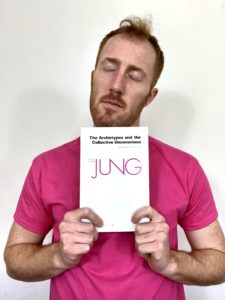 Carl Jung developed his theory about human consciousness over a lifetime of psychological study and psychoanalytical practice with patients. He came to understand that human consciousness existed both consciously and unconsciously, and that the unconscious sides of human beings have a lot in common. People from different countries, cultures, and even time periods have expressed similar unconscious impulses and desires, and he reasoned that we all must have something in common, buried deep within our unconscious. He called these unconscious human similarities archetypes, which he defined as “instinctive data of the dark, primitive psyche, the real but invisible roots of consciousness.”
Carl Jung developed his theory about human consciousness over a lifetime of psychological study and psychoanalytical practice with patients. He came to understand that human consciousness existed both consciously and unconsciously, and that the unconscious sides of human beings have a lot in common. People from different countries, cultures, and even time periods have expressed similar unconscious impulses and desires, and he reasoned that we all must have something in common, buried deep within our unconscious. He called these unconscious human similarities archetypes, which he defined as “instinctive data of the dark, primitive psyche, the real but invisible roots of consciousness.”
Some of the most common archetypes explored in his work are the persona, the shadow, the anima or animus, and the self. The persona is equivalent to the social ‘masks’ that we all wear in different social situations. We wear a different ‘mask’ when around our family members, our coworkers, or our friends. The persona allows people to adapt to the social world around them and fit in. “The shadow personifies everything that the subject refuses to acknowledge about himself,” for instance, repressed ideas, weaknesses, desires, and instincts. The same way that the persona grows out of a need to behave appropriately in different social settings, the shadow grows out of a need to adapt to different cultural norms. The shadow contains all of the things that are unacceptable to society or to one’s own personal morals and values.
The anima and animus are the latent feminine and masculine traits, respectively, which reside within the unconscious of men and women. When babies are first developing in a mother’s womb, they are a mix of both genders, until one ultimately becomes the dominant. The other gender, however, still resides within, buried inside the unconscious. A lot of Jung’s work can be observed through a similar balance of opposites. The ‘whole’ individual is a perpetual balancing and recalibrating of the conscious and the unconscious, which are often in conflict with one another. This is also the archetype known as the self. (This is similar to yin-yang theory and is analogous to the relationship between Christ and God.) The self is the present understanding of the conscious ego as it relates to the unconscious.
All of these unconscious archetypes are in a constant state of change as they fight for recognition by the conscious mind. The persona is a reflection of social situations; the shadow is that of cultural norms; the anima and animus are the balance of gender within an individual; the self is one’s conscious understanding of the sum of one’s own consciousness and unconsciousness.
While these are the most popular archetypes Jung proposed, there are many, including the father, the mother, the child, the hero, the maiden, the trickster, and more. They are usually acknowledged and expressed in dreams, when the bridge between the conscious and unconscious is most open. They sometimes also occur during intense emotional states of mind when emotions take over and the unconscious explodes outwards. “As a rule, unconscious phenomena manifest themselves in a fairly chaotic and unsystematic form,” first and foremost, in metaphors. One of Jung’s most important discoveries and modes of psychotherapy is the universally observed image of the mandala. The mandala is a metaphor for the self and can be found in pictures throughout time, from the earliest artworks of primitive peoples to the unguided drawings of Jung’s patients. A mandala “is the premonition of a centre of personality, a kind of central point within the psyche, to which everything is related, by which everything is arranged, and which is itself a source of energy.” It makes logical sense when you think about it: a mandala is a circle, and the self exists in the middle.
So, the conscious and unconscious are always in a state of flux, either in harmony or disharmony, but never static. This is important, because this fluctuation is the basis for individual growth. The more the conscious mind can accept and understand its unconscious persona, the better it can operate in social situations. The more it accepts its shadow, the better it can express itself fully in society. Similarly, the more it understands about its anima or animus, the better it can understand itself as a ‘whole’ individual. The acceptance of one’s unconscious archetypes is paramount for psychological growth. It is a process that never ends, analogous to the river of life.


